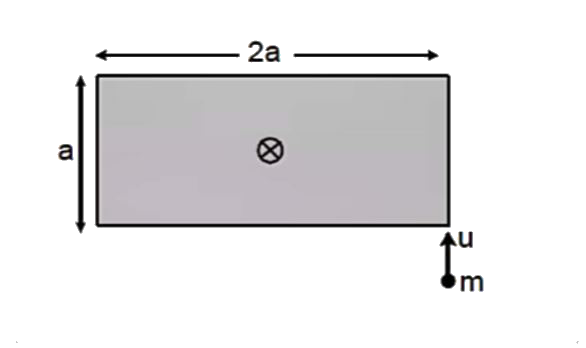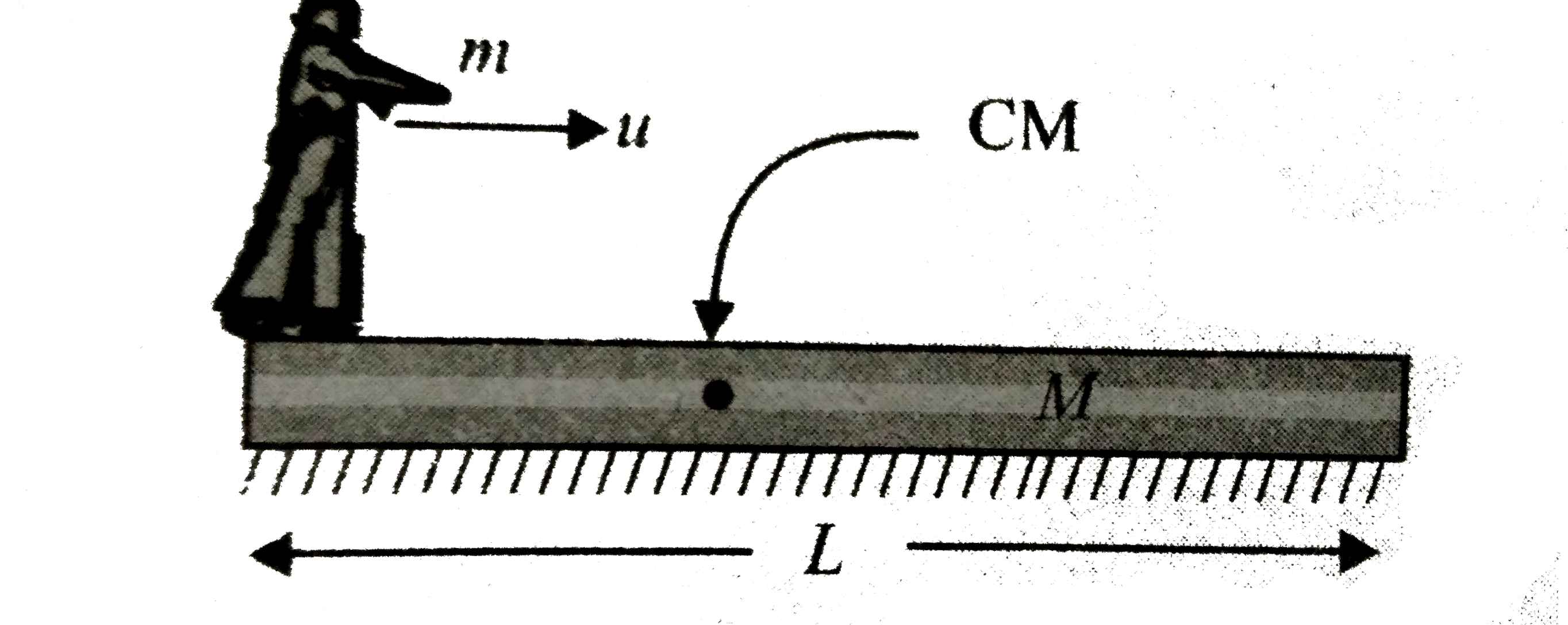Three masses m , 2m and 3m are moving in X-Y plane with speed 3u , 2u and u respectively as shown in figure . The three masses collide at the same point at P and stick together . The velocity of resulting mass will be :

u12(ˆi+√3ˆj)
u12(ˆi−√3ˆj)
u12(−ˆi+√3ˆj)
u12(−ˆi−√3ˆj)
The correct Answer is:B
Conservation of linear momentum
m1u1+m2u2+m3u3=m1v1+m2v(2)+m3v3
Given , m1=m,m2=2mandm3=3m
u1=3u,u2=2uandu3=u
Let all the three masses moving with velocity = →v
Taking component velocity of each mass on XY plane and solve as
m×3u(ˆi)+2m×2u(−ˆicos60∘−ˆjsin60∘)
+3m×u(−ˆicos60∘+ˆjsin60∘)=(m+2m+3m)→v
+3m×u(−ˆicos60∘+ˆjsin60∘)=(m+2m+3m)→v
3muˆi−4mu(√32ˆj)−3muˆi2+3mu(√32ˆj)
=6m→v
⇒muˆi−32muˆi−√32muˆj=6m→v
⇒−12muˆi−√32muˆj=6m→v
⇒ →v=u12(−ˆi−√3)ˆj)
Topper's Solved these Questions
- BOOK - MODERN PUBLICATIONCHAPTER - WORK, ENERGY AND POWER EXERCISE - Objective Type Questions (JEE (Advanced) for IIT Entrance)7videos
WORK, ENERGY AND POWER
- BOOK - MODERN PUBLICATIONCHAPTER - WORK, ENERGY AND POWER EXERCISE - Objective Type Questions (C. Multiple Choice Questions)16videos
WORK, ENERGY AND POWER
- BOOK - MODERN PUBLICATIONCHAPTER - WORK, ENERGY AND POWER EXERCISE - Objective Type Questions (B. Multiple Choice Questions)46videos
WORK, ENERGY AND POWER
- BOOK - MODERN PUBLICATIONCHAPTER - WAVESEXERCISE - CHAPTER PRACTICE TEST14videos
WAVES
Similar Questions
Two bodies of masses m and 2m are moving along positive x and y axes respectively with equal speed 4ms−1. They collide at origin and stick together. The final velocity of combined mass is
View SolutionTwo bodies of masses m and 2m are moving along positive x and y axes respectively with equal speed 4 ms−1. They collide at origin and stick together. The final velocity of combined mass is
View Solution
Knowledge Check
- Question 1 - Select One
Two bodies of masses m and 2m are moving along positive x and y axes respectively with equal speed 4ms−1. They collide at origin and stick together. The final velocity of combined mass is
A(4ˆi+8ˆj)ms−1B(43ˆi+83ˆj)ms−1C(43ˆi+8ˆj)ms−1D(4ˆi+83ˆj)ms−1 - Question 2 - Select One
A particle of mass 2m moving with velocity v strikes a stationary particle of mass 3m and sticks to it . The speed of the system will be
A0.8vB0.2vC0.6vD0.4v - Question 3 - Select One
A particle of mass m moving with speed u collides with the plate of mass m and sticks to it as shown in figure. The recangular place is free to rotae about an axis passing through the centre in horizontal plane. After the collision, the angular velocity of the place will be:
 A125uaB1219uaC32uaD35ua
A125uaB1219uaC32uaD35ua
Two particles, A and B of masses m and 3m, are moving along X and Y axes respectively, with the same speed v. They collide at the origin, and coalesce into one body, after the c ollision. What is the velocity of this coalesced mass ?
View SolutionTwo particles, A and B of masses m and 3m, are moving along X and Y axes respectively, with the same speed v. They collide at the origin, and coalesce into one body, after the c ollision. What is the velocity of this coalesced mass ?
View SolutionA man of mass m moves on a plank of mass M with a constant velocity u with respect to the plank, as shown in figure.
a.If the plank rests on smooth horizontal surface, determine the velocity of the plank. . View Solution
View SolutionA particle of mass 2m moving with velocity v strikes a stationary particle of mass 3m and sticks to it . The speed of the system will be
View SolutionA particle of mass 2m moving with velocity v strikes a stationary particle of mass 3m and sticks to it. The speed of the system will be
View Solution

